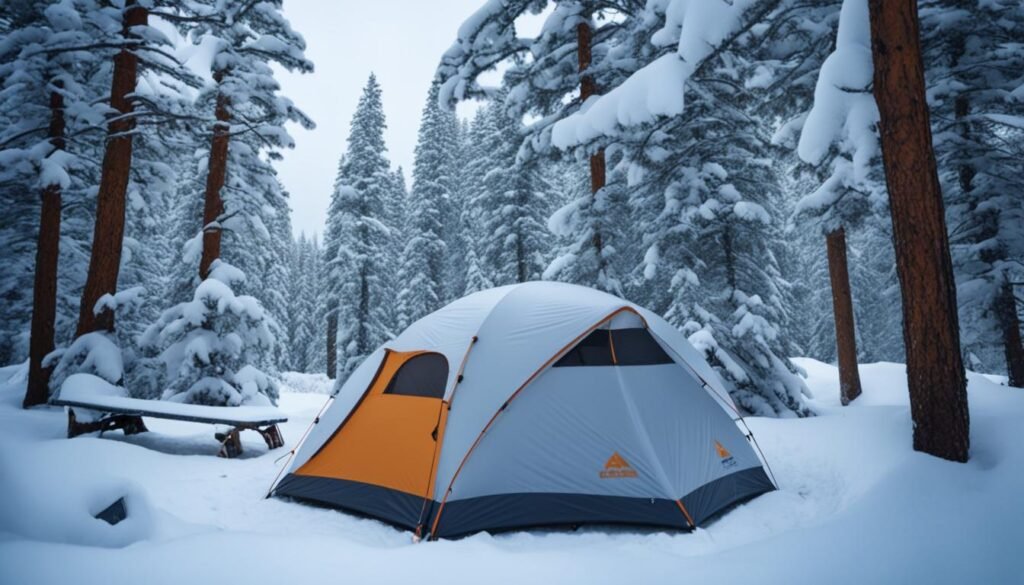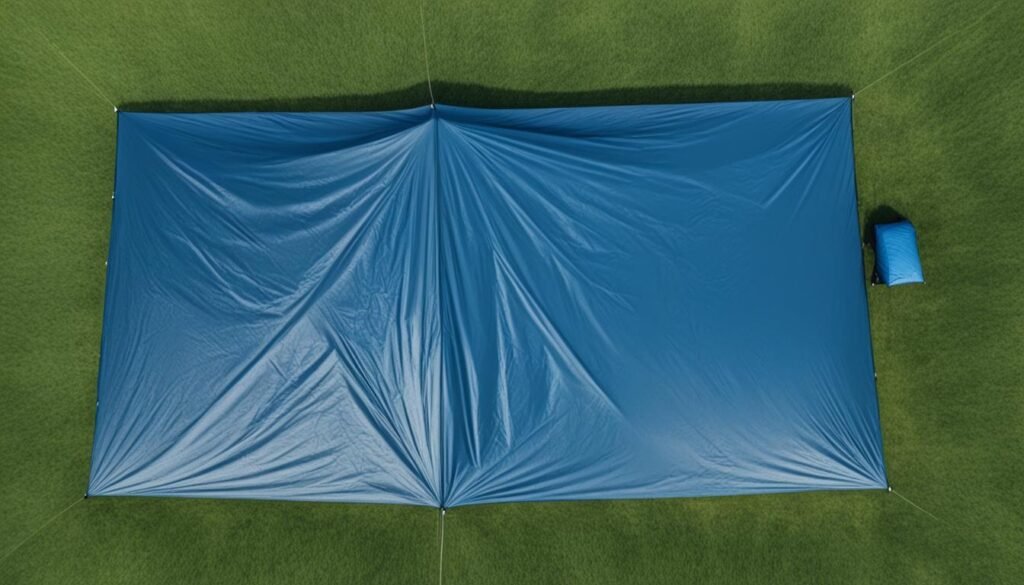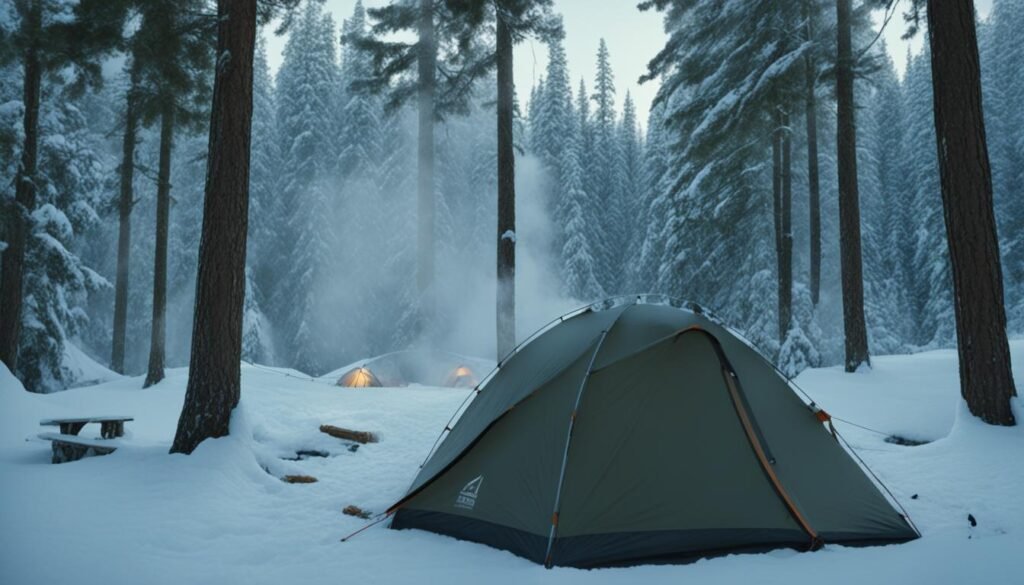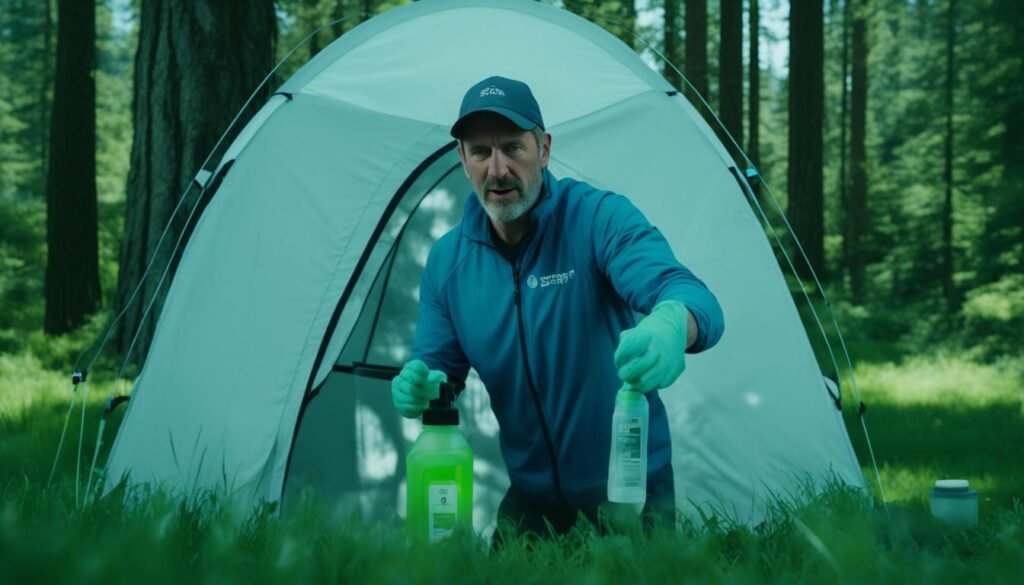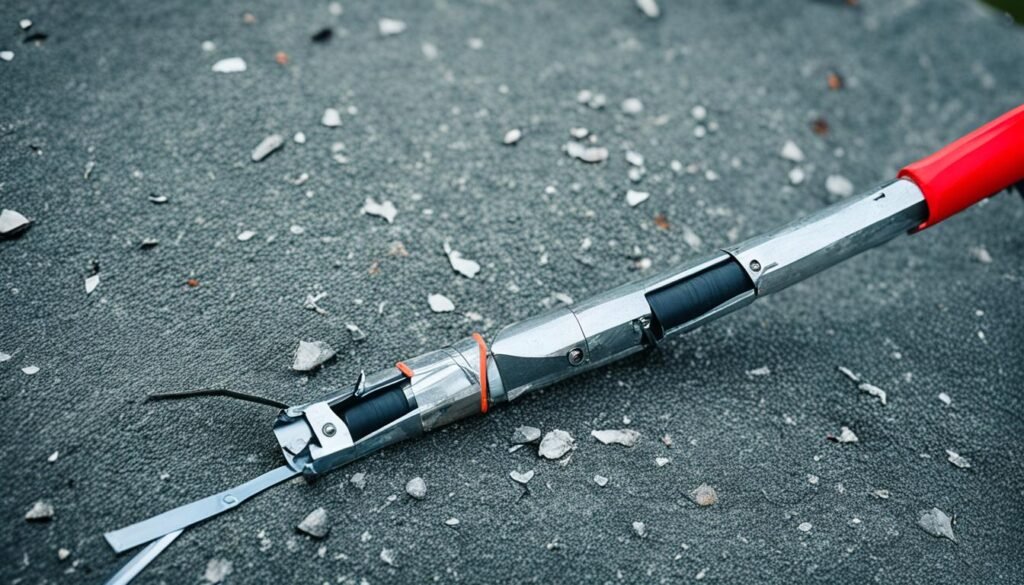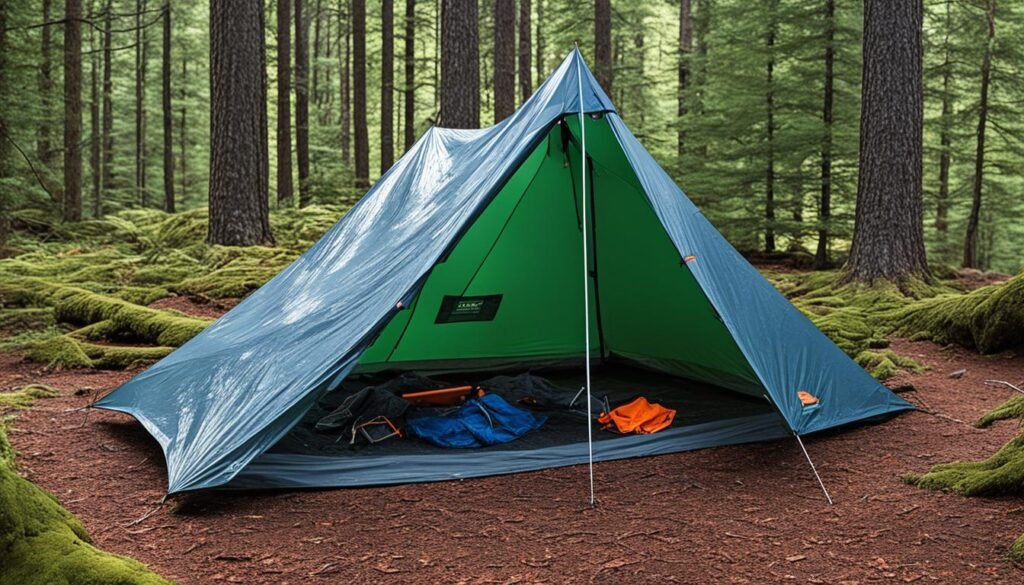Condensation can be a common issue when camping in winter, leading to a wet and uncomfortable experience. It is important to take preventive measures to minimize condensation buildup in your tent. By following these tips, you can keep condensation out and enjoy a dry and cozy camping trip.
Vent Your Tent
One of the most effective ways to reduce condensation in your tent during winter camping is to properly ventilate it. By opening the vents and doors of your tent, you create a pathway for moist air to escape and fresh air to circulate in. This exchange of air helps prevent the buildup of condensation, keeping the interior of your tent dry and comfortable.
If your tent has side vestibules, make sure to open them wide as well. This allows for better airflow and helps prevent frost buildup inside the tent. Remember, venting through a larger opening is more effective in reducing condensation, so prioritize opening the main vents and doors whenever possible.
Importance of Ventilation
Ventilation plays a critical role in condensation control during winter camping. When the temperature inside the tent is higher than the temperature outside, and moisture-laden air is generated through activities such as breathing and sweating, it can lead to condensation on the tent’s inner surfaces. Proper ventilation allows excess moisture to escape, preventing it from accumulating and causing discomfort.
“Opening up the vents and doors of your tent helps create a natural airflow, minimizing the chances of condensation.”
Strategies for Ventilation
Here are some tips to maximize the ventilation in your tent:
- Ensure that all vents are fully open and unobstructed. Clear away any debris or snow that may be blocking the vents.
- Position your tent in a way that takes advantage of natural wind patterns. Placing the vents facing the wind direction can facilitate airflow.
- Consider using a tent with adjustable vents or mesh panels specifically designed for improved airflow.
By following these ventilation tips, you can significantly reduce condensation inside your tent and create a more enjoyable camping experience.
Don’t Cook in Your Tent
One of the best practices for managing tent condensation and avoiding moisture buildup in your winter tent is to refrain from cooking inside your tent. Cooking or melting snow inside the tent releases a significant amount of moisture into the air, which can lead to condensation on the tent walls and ceiling.
If possible, it’s highly recommended to cook outside of your tent. However, if the weather conditions make it necessary to cook inside, there are measures you can take to minimize moisture buildup. One effective method is to dig a hole outside your tent’s front porch and cook inside it with the tent door closed.
This technique helps contain the moisture within the hole, preventing it from spreading throughout the tent and reducing the overall condensation. It’s crucial to ensure proper ventilation while cooking in the hole, as carbon monoxide from the stove can still be hazardous. Always prioritize safety by having a carbon monoxide alarm and ensuring the hole has adequate ventilation.
By following these best practices, you can manage tent condensation and maintain a dry and comfortable camping experience in winter.
Benefits of Not Cooking in Your Tent:
- Minimizes moisture buildup
- Reduces the risk of condensation
- Preserves the dryness and comfort inside the tent
- Prevents potential carbon monoxide exposure
“Cooking outside the tent is the safest and most effective way to avoid moisture buildup and condensation in winter camping.” – Outdoor Expert
| Pros of Cooking Outside | Cons of Cooking Inside |
|---|---|
| Minimizes condensation | Increases condensation |
| Reduces the risk of carbon monoxide poisoning | Potential exposure to carbon monoxide |
| Avoids food odors inside the tent | Food odors can attract wildlife |
Don’t Bring Snow into Your Tent
When camping in cold weather, it’s important to minimize condensation and prevent frost from forming inside your tent. One common mistake that campers make is bringing snow into the tent, which can lead to melting and increased humidity. To keep your tent dry and comfortable, follow these tips:
- Before entering the tent, take the time to brush off all snow from your boots, clothes, and gear. This will help prevent any excess moisture from entering the tent.
- If your tent has a vestibule, leave any snow-covered gear there instead of bringing it into the main tent area. This will further reduce the chances of moisture buildup.
By keeping snow out of your tent, you can minimize the risk of condensation and frost accumulation. Take the extra step to shake off any snow before entering the tent and utilize the vestibule space if available. These simple actions can go a long way in ensuring a dry and comfortable winter camping experience.
Don’t Exhale into Your Sleeping Bag
During cold nights, it can be tempting to bury your head inside your warm sleeping bag. However, exhaling moisture into the insulation can lead to condensation, creating a damp and uncomfortable sleeping environment. To prevent frost inside your tent and maintain the insulating properties of your sleeping bag, it’s essential to keep your face clear and avoid exhaling directly into it.
Exhaling inside your sleeping bag introduces moisture into the insulation material, which can lead to the formation of frost on the inner surface. Moisture buildup reduces the effectiveness of the sleeping bag’s insulation, making it feel colder and potentially compromising its ability to keep you warm throughout the night.
To minimize condensation and frost formation, make sure to breathe away from your sleeping bag. Position your head outside the top opening or use a neck gaiter or balaclava to create a barrier between your breath and the sleeping bag. This simple practice will help preserve the insulation and ensure a more comfortable camping experience.
To further reduce condensation and manage moisture inside your tent, consider using a moisture-wicking liner inside your sleeping bag. This liner helps to absorb excess moisture and prevents it from reaching the insulation, keeping your sleeping bag drier and more effective at retaining heat.
Quick Tips:
- Avoid burying your head inside the sleeping bag
- Direct your breath away from the sleeping bag
- Use a neck gaiter or balaclava as a moisture barrier
- Consider using a moisture-wicking liner for added protection
Expert Quote:
“Exhaling into your sleeping bag introduces moisture, which can lead to condensation and frost buildup. Keep your breath away from the insulation to maintain its effectiveness in keeping you warm.”
By following these tips and avoiding exhaling into your sleeping bag, you can effectively minimize condensation and prevent frost inside your tent. This simple practice will help ensure a dry and comfortable camping experience for your winter adventures.
Dry Out Your Sleeping Bag in the Morning Sun
One effective way to minimize condensation in your cold weather tent is to ensure your sleeping bag is dry. If the weather permits, take advantage of the morning sun to dry out your sleeping bag. Open it up and lay it in a sunny spot, allowing the sunlight to penetrate and evaporate any moisture trapped inside. Many sleeping bags are designed with dark-colored interiors, which help absorb the sun’s radiation and accelerate the drying process.
By ensuring your sleeping bag is dry before bringing it back into your tent, you can significantly reduce the risk of condensation. Wet or damp sleeping bags contribute to moisture buildup inside the tent, which can compromise insulation and make for an uncomfortable camping experience.
Remember, prevention is key when it comes to minimizing condensation. Taking the time to dry out your sleeping bag in the morning sun is a simple yet effective step towards keeping your tent dry and maintaining its warmth-retaining capabilities.
| Tips for Reducing Condensation in Winter Camping | Minimizing Condensation in Cold Weather Tent |
|---|---|
| Properly ventilate your tent by opening vents and doors. | Choose a tent with good ventilation and consider a hi-low venting system. |
| Avoid cooking inside your tent to prevent excess moisture buildup. | Use a stove or dig a hole outside the tent for cooking. |
| Keep snow out of your tent by brushing off gear and leaving snow-covered items in the vestibule. | Avoid bringing wet or snowy gear inside the main tent area. |
| Do not exhale into your sleeping bag to prevent moisture accumulation. | Avoid breathing directly into your sleeping bag to reduce condensation. |
| Dry out your sleeping bag in the morning sun to remove any trapped moisture. | Utilize the sun’s heat to evaporate moisture from your sleeping bag. |
Put Wet Gear into a Stuff Sack
If you find yourself dealing with wet gear during your winter camping trip, it’s important to handle it properly to prevent condensation inside your tent. One effective practice is to put wet gear into a stuff sack instead of trying to dry it inside your sleeping bag.
By placing your wet gear in a separate stuff sack, you can prevent moisture from freezing and keep the contents from getting wet. This not only helps maintain the dryness of your sleeping bag but also reduces the risk of condensation buildup in your tent.
If necessary, you can utilize your body heat to aid in drying the items the next day. Simply wear the wet gear and allow your body heat to gradually evaporate the moisture, increasing the chances of drying them completely.
Remember, keeping wet gear separate from your sleeping bag and utilizing your body heat effectively are best practices to prevent tent condensation and ensure a comfortable camping experience.
| Benefits of Putting Wet Gear into a Stuff Sack | Tips for Effective Drying |
|---|---|
|
|
Vapor Barrier Clothing or Liners
When it comes to preventing tent condensation and minimizing moisture in cold weather tents, some campers opt for using vapor barrier clothing or liners. This technique involves trapping the moisture produced by your body within a specialized layer of clothing or liner, preventing it from reaching the surface of the tent. While this method can effectively reduce condensation on the tent walls, it does come with its own set of pros and cons that should be considered.
“Using vapor barrier clothing or liners can be an effective way to combat condensation in your tent. However, it’s essential to weigh the benefits against the potential drawbacks before incorporating this technique into your winter camping routine.”
The primary benefit of using vapor barrier clothing or liners is their ability to create a barrier that prevents the transfer of moisture to the tent walls. This can significantly reduce the amount of condensation that forms inside the tent, keeping you and your gear dry throughout your camping trip.
However, it is important to note that vapor barrier clothing or liners can lead to the buildup of moisture within the clothing or liner itself. This can result in damp clothing or liners that may feel uncomfortable against the skin. It is essential to carefully consider personal preferences and comfort levels when deciding whether to utilize this technique.
To make an informed decision, consider factors such as the expected temperature, activity level, and personal tolerance for moisture buildup. Experimenting with vapor barrier clothing or liners during shorter camping trips or in less extreme conditions can help you assess their effectiveness and suitability for your specific needs.
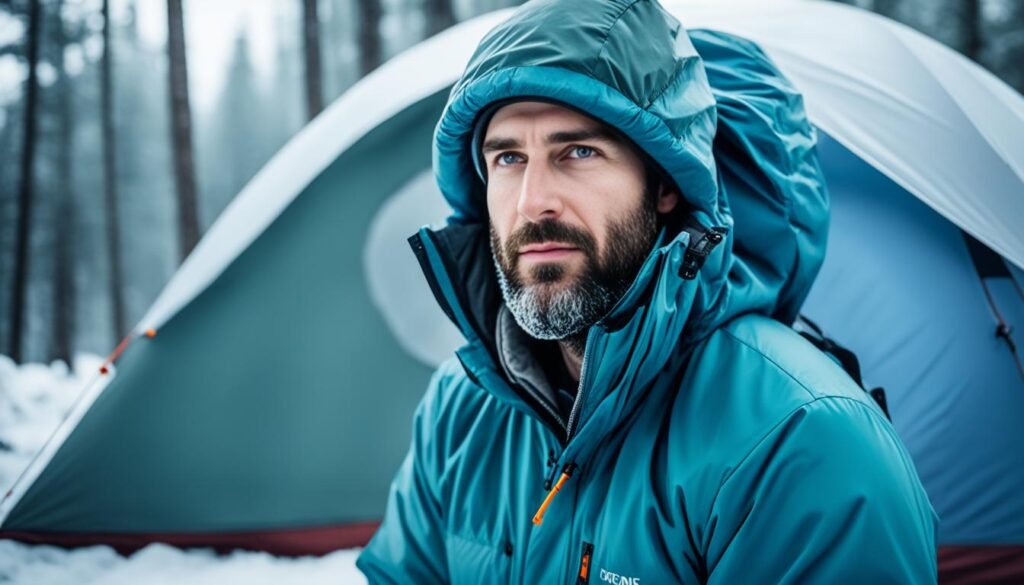
Pros of Vapor Barrier Clothing or Liners:
- Effectively prevents condensation on tent walls
- Keeps you and your gear dry
- Reduces the risk of moisture-related discomfort while sleeping
Cons of Vapor Barrier Clothing or Liners:
- Potential for moisture buildup within the clothing or liners
- Can feel clammy and uncomfortable
- Requires careful consideration based on personal preferences and comfort levels
Hi-Low Ventilation System
Certain tent models feature a hi-low ventilation system, where a corner of the interior door and the fly are open, creating a vent at the top of the tent. This setup promotes a convection current that allows warm, moist air to escape. While it may result in a slight loss of warmth, it helps to maintain lower humidity levels inside the tent.
Why is Hi-Low Ventilation Important?
The hi-low ventilation system plays a crucial role in condensation control during winter camping. By creating a vent at the top of the tent, it allows warm, moisture-laden air to escape, preventing condensation buildup. Without proper ventilation, the moisture in your breath and sweat can accumulate on the tent walls, leading to a damp and uncomfortable camping experience. The hi-low ventilation system helps maintain a balanced humidity level inside the tent and ensures a dry and cozy sleeping environment.
Tips for Utilizing the Hi-Low Ventilation System
Here are some tips for maximizing the effectiveness of the hi-low ventilation system:
- Ensure that both the corner of the interior door and the fly are properly open to create the vent.
- Position the tent in a way that the vent faces the prevailing wind direction. This will enhance airflow and improve ventilation.
- Keep any gear or obstructions away from the vent area to allow unobstructed airflow.
“The hi-low ventilation system is a game-changer for winter camping. It helps prevent condensation buildup and creates a comfortable sleeping environment even in cold and humid conditions.” – Experienced Winter Camper
By utilizing the hi-low ventilation system, you can significantly reduce condensation inside your tent and enjoy a dry and pleasant winter camping experience.
Use a Tarp or Sleep Under the Stars
For those who prefer minimal condensation, using a tarp instead of a tent or sleeping under the stars can be an option. By eliminating the enclosed space of a tent, condensation buildup is significantly reduced. Sleeping under the stars allows for optimal airflow and natural ventilation, preventing moisture buildup in the sleeping area.
However, it’s important to note that there are potential challenges to consider when choosing this camping method. Wind and precipitation can pose significant obstacles to a comfortable outdoor experience. To mitigate wind-related issues, using a bivy sack can provide added protection and insulation while still allowing for a more open sleeping arrangement. A bivy sack acts as a minimalist shelter system, minimizing condensation while also offering protection against wind and light rain.
Even though sleeping under the stars or using a tarp can reduce condensation, it’s essential to be aware that some moisture buildup may still occur, depending on the weather conditions and your camping location. It’s important to prepare for potential moisture-related issues by maintaining proper gear and taking appropriate measures to ensure comfort and safety.
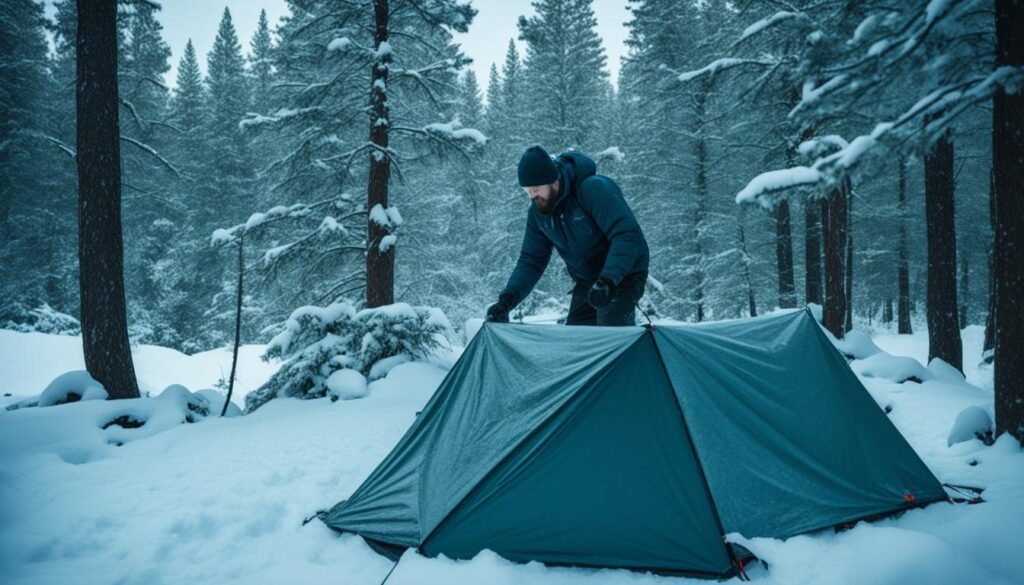
| Pros | Cons |
|---|---|
| Minimizes condensation buildup | Potential challenges with wind and precipitation |
| Optimal airflow and natural ventilation | Possibility of moisture buildup depending on weather conditions |
| Less restricted sleeping space |
Best Practices:
- Choose a suitable location with natural windbreaks to minimize wind exposure.
- Check the weather forecast before sleeping under the stars to avoid unexpected rain or snow.
- Ensure proper insulation and warmth with appropriate sleeping bags and clothing.
- Consider using a bivy sack for added protection against wind and light precipitation.
Sleeping under the stars can provide a unique and immersive camping experience while reducing some of the issues associated with tent condensation. However, it’s important to evaluate the weather conditions and potential challenges before opting for this sleeping arrangement. By following best practices and being prepared, you can enjoy a comfortable and condensation-free camping trip.
Frost Liner
In cold weather camping, condensation can pose a challenge inside your tent. However, some expedition tents come equipped with a frost liner that can help manage and minimize condensation buildup.
A frost liner acts as a barrier between the interior of the tent and the condensation forming on the tent walls. It allows vapors from your body to pass through while reducing the amount of frost that accumulates. This can prevent a “tent-snow storm” scenario where movement dislodges the frost, causing it to fall onto your gear and sleeping area.
| Benefits: | Considerations: |
|---|---|
|
|
Using a frost liner can be beneficial for managing tent condensation in cold weather conditions. However, it’s important to ensure compatibility with your tent model and consider any additional weight or bulk it may add. With a frost liner, you can enjoy a drier and more comfortable camping experience even in challenging weather conditions.
What are Some Effective Strategies for Preventing Condensation in a Tent During Rain?
When it comes to staying dry in a tent during rain, there are several effective strategies for keeping tent dry. One option is to use a rainfly or tarp over the tent to provide an extra layer of protection. Additionally, ensuring proper ventilation inside the tent can help minimize condensation buildup.
Is Condensation in the Tent a Common Cause of Mold and Damage?
Yes, condensation in the tent is a common cause of mold and damage if not addressed properly. Ensuring you are drying your tent properly after use can help prevent the build-up of moisture that leads to these issues. Proper maintenance is crucial for extending the lifespan of your tent.
Conclusion
Managing condensation in a tent during winter camping requires careful attention to ventilation, cooking practices, and personal habits. By venting your tent, avoiding cooking inside, keeping snow out, and being mindful of air moisture, you can significantly minimize condensation buildup.
Remember to dry out your gear and sleeping bag in the sun and consider using vapor barriers or a frost liner when necessary. Following these best practices will help ensure a dry and comfortable winter camping experience.
FAQ
How can I prevent condensation buildup in my tent during winter camping?
Ventilating your tent is crucial for reducing condensation. Opening the vents, doors, and side vestibules of your tent allows moisture to escape and fresh air to enter, helping to keep condensation out.
Should I cook inside my tent in cold weather?
It is best to avoid cooking inside your tent. Cooking or melting snow inside can create a significant amount of moisture, leading to condensation. If necessary, consider cooking in a designated area outside your tent, such as a hole dug in the snow, to minimize moisture buildup.
How can I prevent snow from entering my tent?
Brush off all snow from your boots, clothes, and gear before entering the tent. If you have a vestibule, leave any snow-covered gear there to prevent moisture from entering the main tent area.
Can exhaling into my sleeping bag cause condensation?
Yes, exhaling moisture into your sleeping bag can lead to condensation. Keep your face clear of the sleeping bag and avoid exhaling directly into it to minimize condensation buildup.
How can I dry out my sleeping bag in the morning?
If the weather permits, open up your sleeping bag in the morning sunlight to allow it to dry out. Many sleeping bags are designed with dark-colored interiors to absorb the sun’s radiation and accelerate drying. This helps to reduce condensation and maintain its insulating properties.
What should I do with wet gear inside my tent?
Instead of trying to dry wet gear inside your sleeping bag, place it in a stuff sack and keep it separate. This prevents the moisture from freezing and keeps the contents from getting wet. If necessary, use your body heat to dry the items by wearing them the next day.
Should I use vapor barrier clothing or liners to prevent condensation in my tent?
Some campers use vapor barrier clothing or liners to trap moisture and prevent it from reaching the surface of their tents. This method can reduce condensation on the tent walls but may lead to moist clothing or liners. Consider using vapor barriers based on individual preferences.
What is a hi-low ventilation system and how does it help with condensation?
Certain tent models feature a hi-low ventilation system, where a corner of the interior door and the fly are open, creating a vent at the top of the tent. This setup promotes a convection current that allows warm, moist air to escape, reducing condensation. However, it may result in a slight loss of warmth.
Can I use a tarp or sleep under the stars to minimize condensation?
Using a tarp instead of a tent or sleeping under the stars can be an option for minimal condensation. However, be aware of potential wind and precipitation challenges. Bivy sacks can mitigate the wind but may not completely eliminate condensation.
What is a frost liner and how does it help with condensation?
Some expedition tents come with a frost liner, which acts as a barrier between the tent and the condensation. The vapors from your body pass through the thin cloth, reducing the amount of frost on the tent walls. This helps prevent a “tent-snow storm” when movement dislodges the frost.
Preventing tent condensation is a common issue when camping in winter, leading to a wet and uncomfortable experience. It is important to take preventive measures to minimize condensation buildup in your tent. By following these tips, you can keep condensation out and enjoy a dry and cozy camping trip.

